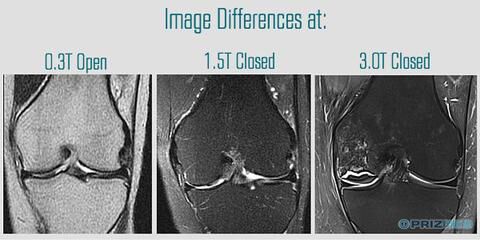Closed MRI vs. Low Field Open MRI
Finding the Right MRI for Optimal Imaging and Care
To use a closed MRI, or to use low field open MRI? That is the question! Because when choosing the right MRI scanner for your hospital, clinic, or private imaging center, there isn't always an "If you need A, then you should get B" answer.

In certain situations, one system will be better suited for your imaging center than the other. At the same time, choosing the right system also depends on your quality-of-care preferences, as explained below:
- Closed MRI systems are more powerful, but they don't address patient comfort and claustrophobia concerns.
- Low field open MRI systems are less powerful, but they do address patient comfort and claustrophobia concerns.
Therefore, for imaging centers that don't require the increased power of closed systems, there is still the question, "What do we want to offer, more powerful machines or machines that are suitable for more patients?"
This post will explore some important differences between closed MRIs and low field open MRIs, with the goal of helping you better decide which system applies to your imaging center's needs and quality-of-care preferences.
Disadvantages of Closed MRIs

Siemens Magnetom Verio 3.0T
You can identify a closed MRI system by its outward appearance. Most will look similar the Siemens Magnetom Verio 3.0T pictured on the right. As illustrated, closed MRIs have the donut-like design with a central, narrow bore that averages about 60 cm in diameter.
Now, this horizontal tube (the bore) presents the foremost disadvantage of closed MRI systems. During an MRI exam, the patient is completely encircled inside the magnet. Combine a nearly "buried alive" feeling with the loud buzzing noises (which can be as loud as a train whistle in some systems), the closed systems are not patient-friendly and they can present claustrophobia challenges.
Moreover, patients who experience claustrophobia can present cost disadvantages as well. These costs often come in the form of sedatives or re-testing needs due to patient movement during the scan.
Advantages of Closed MRIs
Closed MR systems are tight, loud, and claustrophobic. Why would any imaging center want such a machine?
Well, the answer is simple—power. The strength of an MRI machine is measured in Tesla (T). Higher Tesla strength means a stronger magnetic field and, therefore, clearer images of deep tissues.
On average, closed MRIs have a field strength of 1.5T and can reach up to 3.0T. The "gold standard" for MRI imaging is typically 1.5T, and this level of field strength will be ideal for most imaging center needs. A few advantages of a 3.0T MRI include:
- Lesion detection in multiple sclerosis
- Identification of single- or multi-vessel diseases in patients with CAD
- Nerve visibility for brachial plexus
- Visibility of anatomic structures in the wrist
- Identification of fibrocartilage lesions
- Diagnostic accuracy for hepatic metastases
Disadvantages of Low Field Open MRIs
In direct comparison with the section above, the main disadvantage of low field open MRIs is their low Tesla strength. On average, open MRIs feature between 0.3T and 0.7T, with some systems reaching up to 1.2T. Below is a visual comparison of the three field strengths we've already discussed:

As you can see in the image above, a low field strength makes it more difficult for the MRI to clearly discern the signal differences between water and fat. This means that you'll receive lower resolution of small body parts.
But it is important to note that "quality of imaging" and "ability to diagnose" are two different things. For instance, in a 2000 study published in European Radiology, researchers conducted an arthrography of the shoulder using a 0.2T MRI and a 1.5T MRI. Their findings showed that a diagnostic accuracy with surgical correlation was the same for both systems.
Advantages of Low-Field Open MRIs

Philips Panorama .23T Open MRI
The most significant advantage of a low field open MRI is its patient-friendly, non-claustrophobic design. As illustrated with the Philips Panorama .23T Open MRI pictured here, patients can easily look around the room, perhaps watch a television, or, in the case of children, they can hold a family member's hand.
The open design of these systems also allows for more patient positioning options; you can place critical body parts directly under the magnet without causing undue pain in the patient.
About 1-in-10 people experience claustrophobia; open MRIs can help with this during diagnostic imaging. As a result of its accommodating design, open MRIs can often admit more patients for diagnostic exams.
Which MRI System is Right for You?
If your imaging center or radiology department focuses on deep tissue imaging, whereas tiny nuances in the body have huge implications for a diagnosis, then the low field strength of open MRIs may not be for you.
But for most uses of an MRI, whereas the lower Tesla strength isn't an issue, the question is, "clearer diagnostic imaging or quality care."
If you’re not sure whether an open or a closed MRI is right for you, speak with one of our expert sales representatives by contacting us or calling today at 440-414-7539.